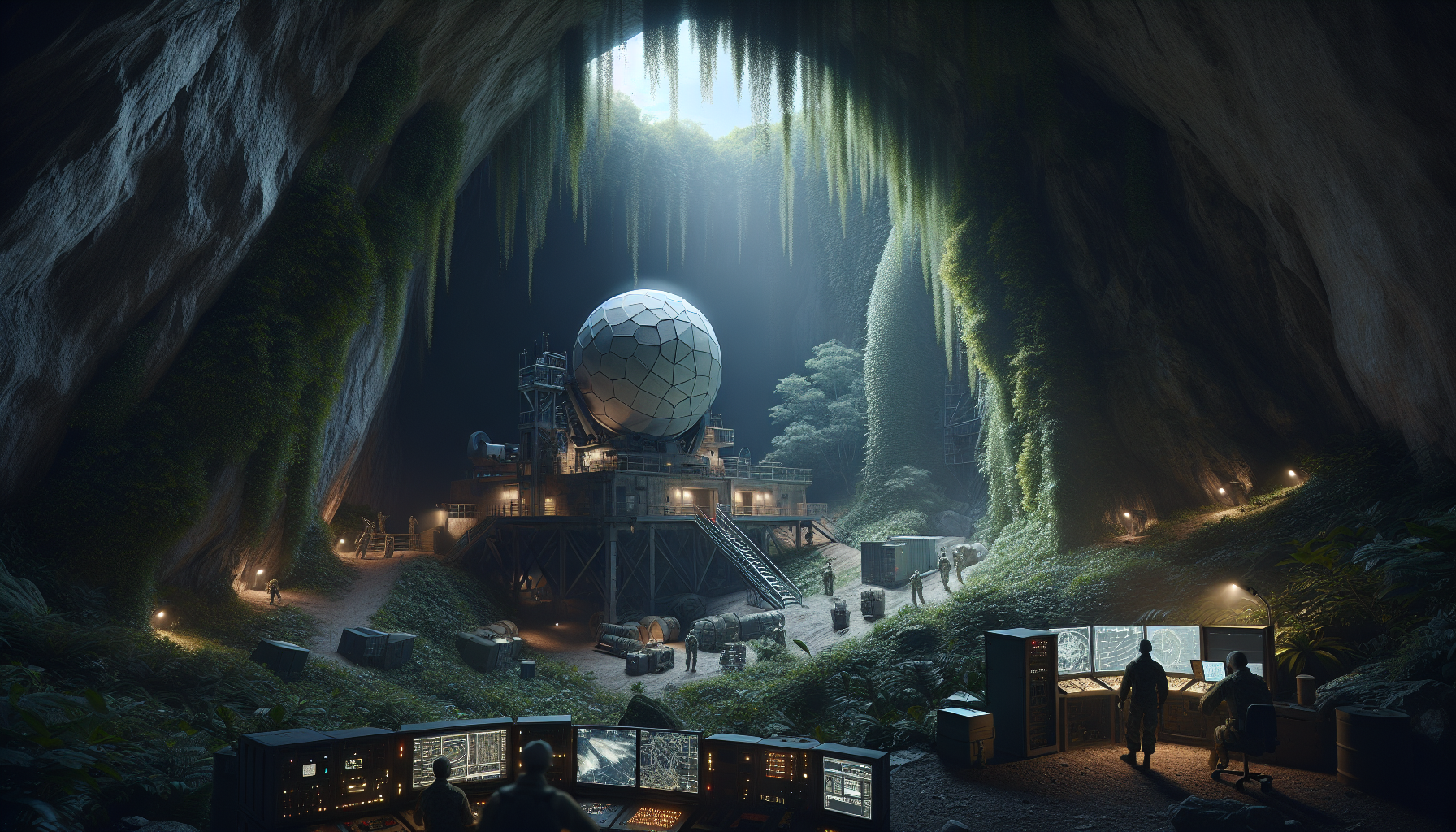In the intricate dance of modern technology and strategic defense, there exists a world hidden from the public eye, a realm where nature and innovation merge to create something truly extraordinary. Imagine the seemingly innocuous mountains and rolling hills that dot our landscapes. Beneath their rugged, untouched surfaces lie not just the mysteries of the earth but also the cutting-edge marvels of human ingenuity: radar stations concealed within caves. These hidden fortresses are more than just technological feats; they are pivotal guardians of our skies, employing stealth technology to monitor and protect with unparalleled precision.
The story of radar stations tucked away in the depths of caves is one that intertwines science, history, and a touch of espionage intrigue. At a glance, the idea might seem plucked from the pages of a spy thriller or a sci-fi novel, yet it is a reality shaped by the necessity of national security and the relentless pursuit of technological advancement. These subterranean sanctuaries offer an array of strategic advantages, such as protection from external threats, reduced environmental impact, and enhanced operational efficiency, thanks to the natural insulation provided by the surrounding rock formations. It’s an elegant solution that ensures these systems remain operational even in the face of potential attacks or environmental challenges.
As we embark on this journey to uncover the secrets of these hidden radar stations, we’ll explore the historical context that led to their development. The Cold War era, with its relentless arms race and the omnipresent fear of aerial attacks, was a significant catalyst in the push for advanced radar technology. During this period, nations around the globe sought ways to safeguard their airspace without exposing critical infrastructure to enemy eyes. The solution was as ingenious as it was effective: concealment within the earth itself. This not only shielded the installations from prying eyes and potential sabotage but also demonstrated a profound understanding of how to leverage natural formations for technological progress.
Our exploration will delve into the technical intricacies that make these radar stations so effective. We will demystify the science behind radar technology, explaining how electromagnetic waves are used to detect objects, measure distances, and track movements with astonishing accuracy. Moreover, we’ll shine a light on the stealth technologies employed within these caves, such as materials that absorb radar waves and advanced algorithms that filter out noise, ensuring that the systems remain undetectable to external monitoring efforts. These innovations represent the cutting edge of defense technology, pushing the boundaries of what is possible and setting new standards for security measures worldwide.
Finally, we’ll examine the broader implications of these hidden radar stations on global security and geopolitics. In an era where the skies are increasingly crowded with both civilian and military aircraft, the ability to monitor and manage air traffic is more crucial than ever. These concealed radar installations play a vital role in maintaining peace and stability, providing nations with the assurance that their airspace is vigilantly protected. As we uncover the secret world within the caves, we’ll reflect on the delicate balance between innovation and secrecy, pondering the ethical considerations and future possibilities as technology continues to evolve. Join us on this captivating journey into the depths of the earth, where the ancient and the modern coalesce to keep our skies safe. 🌍✨
The Hidden World of Radar Stations in Caves
In the intricate tapestry of global defense systems, radar stations play a pivotal role in ensuring the safety of our skies. These installations, equipped with advanced technology, are responsible for detecting and tracking aircraft, missiles, and other airborne threats. However, in an age where stealth and secrecy are paramount, the traditional above-ground radar stations can become vulnerable targets. This realization has led to the innovative concept of concealing radar stations within natural caves, leveraging the earth’s natural topography to enhance security and operational efficiency.
The idea of using caves as protective enclosures for sensitive installations is not new. Throughout history, caves have served as refuges and fortresses, offering natural protection against external threats. In the context of modern defense, caves provide a unique combination of natural camouflage and structural integrity. When radar stations are placed within these geological formations, they are shielded from aerial surveillance and potential attacks, effectively becoming invisible to enemy reconnaissance.
Beyond mere concealment, the use of caves offers significant logistical and strategic advantages. The natural insulation provided by the surrounding rock helps in maintaining stable internal temperatures, which is crucial for the sensitive electronic equipment used in radar operations. Moreover, the acoustics within a cave can be manipulated to enhance the performance of radar systems, improving their ability to detect and track objects at great distances. This strategic use of natural landscapes not only enhances defense capabilities but also reduces the environmental footprint of military installations.
Historical Use of Caves for Defense
The concept of utilizing caves for defense purposes dates back to ancient civilizations. From the hidden monasteries in the cliffs of Cappadocia to the fortified caves used during World War II, the strategic use of natural formations has been a recurring theme in military history. The inherent advantages of caves – their inaccessibility, concealment, and natural defense – make them ideal for safeguarding valuable assets and personnel.
During World War II, several countries employed cave systems to house military facilities. The Swiss, for instance, famously built a series of fortifications known as the Réduit National, which included a network of bunkers and tunnels carved into the mountains. These fortifications were designed to be self-sufficient and capable of withstanding prolonged sieges. Similarly, in the Pacific theater, the Japanese utilized cave systems to protect their troops and supplies from Allied bombing campaigns.
Today, the legacy of these historical applications continues to inspire modern defense strategies. As technology evolves, so too do the methods by which countries protect their interests. The integration of advanced radar systems into cave networks is a testament to the enduring relevance of natural defenses in an increasingly digital world.
Advantages of Concealed Radar Stations
The decision to place radar stations within caves is driven by a multitude of factors, each contributing to the overall effectiveness and security of these installations. One of the primary advantages is the enhanced protection from physical and electronic attacks. Caves offer a natural barrier against conventional weaponry, such as missiles and bombs, which would struggle to penetrate the dense rock formations. Additionally, the enclosed environment limits the effectiveness of electronic warfare tactics, such as jamming or spoofing, that rely on line-of-sight disruptions.
Another significant advantage is the reduced radar cross-section (RCS) of the installations themselves. By housing radar systems within caves, their presence is masked from enemy radar detection, allowing them to operate undetected. This stealth capability is crucial in maintaining the element of surprise and ensuring the continuous monitoring of potential threats. Moreover, the remote and often inaccessible locations of these caves further complicate enemy attempts to locate and neutralize the radar stations.
The logistical benefits of using caves are also noteworthy. The natural insulation provided by the surrounding rock helps maintain stable temperatures, reducing the need for energy-intensive climate control systems. This not only lowers operational costs but also minimizes the environmental impact of the installations. Furthermore, the acoustics within a cave can be optimized to enhance radar performance, allowing for more precise detection and tracking of objects. This combination of stealth, protection, and efficiency makes concealed radar stations a highly attractive option for modern defense planners.
Technological Innovations in Radar Systems
The integration of advanced radar technology into cave networks is a complex endeavor that requires careful planning and execution. Modern radar systems are sophisticated pieces of technology, capable of detecting and tracking objects at long distances with high accuracy. These systems rely on a combination of hardware and software components, each playing a crucial role in the overall functionality of the radar station.
One of the key technological innovations in radar systems is the development of phased array technology. Unlike traditional radar systems that rely on a rotating antenna to scan the skies, phased array radars use a series of stationary antennas that can electronically steer the radar beam. This allows for faster target acquisition and tracking, as well as the ability to track multiple targets simultaneously. The compact nature of phased array systems also makes them ideal for installation within confined spaces, such as caves.
Another important advancement is the use of artificial intelligence (AI) and machine learning in radar operations. These technologies enable radar systems to automatically identify and classify targets, reducing the workload on human operators and improving overall efficiency. AI algorithms can also analyze vast amounts of data in real-time, providing valuable insights into potential threats and allowing for quicker decision-making.
The combination of these technological innovations with the natural advantages of caves creates a formidable defense system that is both resilient and adaptable. As the threat landscape continues to evolve, the ability to integrate cutting-edge technology with natural defenses will be key to maintaining the security of our skies.
Challenges and Considerations
Despite the numerous advantages of concealing radar stations within caves, there are also significant challenges and considerations that must be addressed. One of the primary challenges is the logistical complexity of establishing and maintaining these installations. The remote and often rugged locations of suitable caves can pose significant difficulties in transporting equipment and personnel to and from the site. This necessitates careful planning and the use of specialized vehicles and equipment to ensure the safe and efficient operation of the radar station.
Another important consideration is the potential impact on the natural environment. While the use of caves can reduce the environmental footprint of radar installations, it is essential to ensure that the construction and operation of these stations do not cause undue harm to the surrounding ecosystem. This requires a delicate balance between achieving strategic objectives and preserving the natural beauty and biodiversity of the area. Environmental impact assessments and sustainable practices must be integrated into the planning and execution of these projects to mitigate any negative effects.
The security of the radar station is also a critical concern. While the natural concealment offered by caves provides a degree of protection, it is essential to implement additional security measures to prevent unauthorized access and sabotage. This includes the use of surveillance systems, access control measures, and regular security patrols to ensure the integrity of the installation. Additionally, contingency plans must be in place to address potential emergencies, such as equipment failures or natural disasters, which could compromise the operation of the radar station.
Future Prospects
As technology continues to advance and the geopolitical landscape evolves, the role of concealed radar stations in national defense strategies is likely to grow. The increasing sophistication of potential adversaries and the emergence of new threats, such as hypersonic missiles and unmanned aerial vehicles (UAVs), necessitate the development of more advanced and resilient defense systems. The use of caves as protective enclosures for radar stations offers a promising solution to these challenges, combining natural and technological advantages to create a robust and effective defense infrastructure.
In the coming years, we can expect to see further innovations in radar technology and the integration of additional capabilities, such as cybersecurity measures and advanced data analytics, into cave-based installations. These developments will enhance the effectiveness and adaptability of radar systems, ensuring their continued relevance in an ever-changing world. As nations seek to protect their airspace and maintain strategic superiority, the use of concealed radar stations in caves will undoubtedly play a crucial role in shaping the future of defense.

Conclusion
Uncovering the secretive world of radar stations concealed within caves has led us on a fascinating journey into the heart of modern stealth technology. Throughout this article, we have delved into the innovative strategies employed to safeguard our skies, focusing on the unique combination of natural landscapes and advanced technology to enhance national security. By embedding radar stations within caves, governments are leveraging the Earth’s natural formations to provide a strategic advantage that is both protective and cost-effective.
Firstly, we explored the historical context that led to the development of these covert installations. The need for robust and reliable defense mechanisms has been a priority since the early days of aerial warfare. With the advancement of technology, the demand for more discreet and resilient radar systems has only grown. This historical overview highlighted how these installations have evolved from simple detection systems to sophisticated networks capable of tracking the most advanced aerial threats.
Our discussion then shifted to the technological innovations that make these radar stations so effective. By using the natural insulation provided by caves, these systems are shielded from both environmental factors and enemy detection, ensuring uninterrupted operation. The integration of cutting-edge radar technology with geological advantages has resulted in a formidable defense tool. These systems are equipped with the latest advancements in signal processing and artificial intelligence, allowing for real-time data analysis and rapid response capabilities.
Moreover, we examined the strategic advantages of using caves as locations for radar stations. These installations are less susceptible to sabotage and can remain operational under conditions that would compromise surface-based systems. The geographical diversity and natural concealment provided by caves make them ideal for housing radar equipment, thereby enhancing the overall resilience of national defense networks.
The environmental benefits of these installations were also a key point of our exploration. By utilizing natural formations, the environmental footprint of constructing new defense infrastructure is significantly reduced. This approach aligns with broader sustainability goals and demonstrates how defense strategies can evolve to be more ecologically conscious without compromising effectiveness.
Importantly, we also touched upon the global perspective, analyzing how different countries are adopting this technology to suit their unique geopolitical needs. This global overview underscored the universal relevance and adaptability of cave-concealed radar stations, illustrating their significance as a crucial component of international security strategies.
As we conclude this exploration, it is vital to underscore the importance of continued innovation in defense technology. In a world where threats are constantly evolving, staying ahead through technological advancements is imperative. The integration of stealth technology, such as radar stations hidden within caves, represents a significant leap forward in ensuring the safety and security of nations worldwide.
We invite you, our readers, to reflect on the remarkable ingenuity behind these concealed radar stations and their role in safeguarding our skies. The discussion on the intersection of technology and nature in defense strategies is a conversation worth continuing. Whether you are a defense enthusiast, a technology aficionado, or someone curious about the innovative ways we protect our world, your insights and perspectives are invaluable.
We encourage you to share this article with your network and spark a dialogue on the future of stealth technology in defense. Engage with us by leaving your thoughts in the comments section below. Your contributions can help shape the future of defense strategies and inspire further innovations in this field.
For those interested in delving deeper into the subject, consider exploring additional resources and studies on stealth technology and defense systems. Websites like The Defense Post and Global Security offer a wealth of information on the latest developments in defense technology and strategies.
In closing, the secretive world of radar stations concealed within caves is not just about technology; it is a testament to human ingenuity and our relentless pursuit of safety. Let us celebrate these advancements and continue to push the boundaries of what is possible, ensuring a safer and more secure world for future generations. Together, through knowledge and collaboration, we can unlock even more secrets and innovations that lie ahead. 🌐🔍
Toni Santos is a visual storyteller and artisan whose work explores the quiet power of what lies beneath. With a deep fascination for subterranean and hidden architecture, Toni uncovers the layers, voids, and forgotten spaces that shape our built environment from the shadows.
His art is a journey through the unseen — from ancient underground chambers to sealed passageways, service tunnels, and foundations buried in time. Each creation tells a story of silence, secrecy, and structure — revealing how absence and concealment can be just as meaningful as what’s visible above ground.
Whether working through visual compositions, architectural studies, or symbolic handcrafted pieces, Toni captures the soul of hidden spaces. His work bridges art and archaeology, blending design with discovery. Trained in visual design and traditional techniques, Toni creates with intention. His pieces don’t just depict — they interpret, inviting viewers to rethink what space, memory, and architecture mean when they’re hidden from view.
As the creative force behind Vizevex, Toni shares this perspective through curated visual narratives, symbolic collections, and interpretive essays that give voice to the quiet geometries beneath our feet.
His work is a tribute to:
The mystery of spaces built to be forgotten
The symbolism embedded in foundations, voids, and passageways
The timeless connection between human intention and hidden structure
Whether you’re an artist, an urban explorer, or someone fascinated by the unseen frameworks that support our world, Toni invites you into a realm where architecture becomes myth — one corridor, one layer, one buried story at a time.





